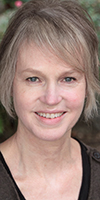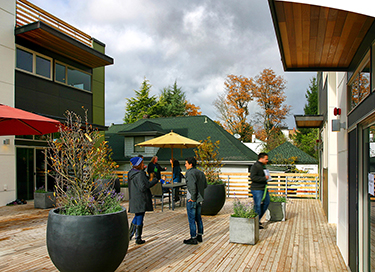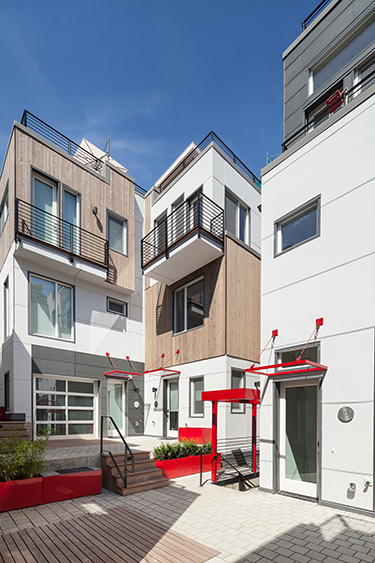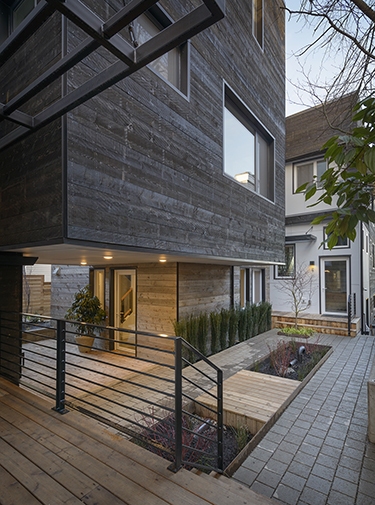|
Subscribe / Renew |
|
|
Contact Us |
|
| ► Subscribe to our Free Weekly Newsletter | |
| home | Welcome, sign in or click here to subscribe. | login |
News
| |

|
|
Design Perspectives By Clair Enlow |
September 14, 2016
Design Perspectives: Townhouses adding density to neighborhoods
Special to the Journal
Seattle is adding density — fast — in new high-rise buildings and big blocks of apartments. But some things aren't changing much — like single-family neighborhoods, with their rules about parking and big setbacks from the street.
Some architects would like Seattle to have more choices, and they are working in low-rise zones, where building types are more mixed. These are neighborhoods for people who don't want a big house with a lawn and garage — but don't want to live in a downtown high-rise or typical apartment block, either. Buyers in these areas may not own a car, or are hoping to live without one. They are okay with some semi-private outdoor areas where they can expect to actually see their neighbors.
Parking optional
In some new Seattle townhouse projects, parking may be shared, off-site or optional. A central courtyard is one way to connect these units without packing them into a big box.
European-leaning View Haus 5, designed by b9 Architects at 208 25th Avenue E. in Madison Valley, was completed last year and sold quickly — with the smaller ones going first. Five townhouses are part of a single, terraced structure. A common walkway connects the site to the street and an alley, and it widens into a courtyard that connects to private decks, similar to front porches. Parking is available in the adjacent alley. Changes made in 2011 to Seattle's multifamily zoning code made this kind of arrangement possible.
Beacon Green Townhomes at 1734 13th Ave. S., completed in 2013, is a courtyard townhome project by Neiman Taber Architects. Front doors open to the courtyard, which is accessible from the street. The courtyard is actually on a deck, with parking tucked underneath. Among the six units, buyers could choose from having a full-sized garage, a mini garage — or no garage at all.
Then there is Marion Green at 918 14th Ave., completed in 2014, and also by Neiman Taber Architects. Like Beacon Green, the common area or courtyard is the primary pedestrian circulation route. It leads to semiprivate deck spaces and serves as a gathering area for group events.
In these complexes, there are many ways residents can find a balance between privacy and community. If they want to, they can forget about driving, at least for awhile. Along with the paved-over driveways, almost all the negative impacts of cars and parking disappear, leaving a seamless connection between the courtyard and the urban neighborhood.
These projects should point to a more urban and walkable future. But realizing this vision requires high quality design, and permit reviewers who understand the issues. There's no formula, because every site is different.
And change is difficult. One of the issues for courtyard projects is that with common space in the middle of the lot, the units themselves are pushed out to the property line on the sides. This could impact current neighbors, or set up conflicts with future ones. It can make neighbors cranky and developers nervous, and puts pressure on reviewers. More clarity at City Hall about the goals of small multifamily development — including walkability and shared open space — could help with permitting courtyard townhouses.
In the meantime, more townhouse units are being added. In b9 Architects' courtyard townhouse projects, unit plans and sizes are all likely to be different, so they can fit a small site like a glove. It's a matter of principle.
“If a site can fit four or five units,” said Brad Khouri of b9 Architects, “build five. Not four.”
Projects of this size, which may include duplex and triplex townhouses, fit in well with traditional single-family-scaled neighborhoods.
Fewer four packs
| Talk Friday at b9 Architects |
|
David Neiman of Neiman Taber Architects will moderate a panel discussion on single-family neighborhoods and the future of zoning in Seattle from 6 to 8 p.m. Friday at the office of b9 Architects, 610 Second Ave.
Participants include Josh Brower of Veris Law Group, architect David Cutler, Gabriel Grant of Spectrum Development Solutions, urban planner and activist Cary Moon, and Nick Welch of the Seattle Office of Planning and Community Development. Reservations are not required for the free event, which is part of Seattle Design Festival. |
Khouri would like to see fewer of the notorious “four-pack” projects. In a typical example of this recent phenomenon, an old house on one single-family lot is replaced by four skinny, peaked-roof homes with garages on the first level and pavement all around. Four-packs are easy to permit, and they have become popular with builders.
Along with relief from parking requirements, some important multifamily zoning changes made in 2011 provide for “streamlined” permitting. But because of the added reviews, permitting may actually be slower than for projects with more private parking. That discourages architects and potential development partners.
(Editor’s note: In an earlier version of this story, this comment was incorrectly attributed to Brad Khouri. Also Neiman Taber Architects was spelled incorrectly.)
“(Courtyard townhouses) are the hardest kind of project to do,” said David Neiman of Neiman Taber Architects, who advocated with Khouri for the 2011 changes.
Along with like-minded designers and activists, Khouri and Neiman would like to see more clarity in zoning, with standards that embrace projects that add small increments of density — and shared open space — to neighborhoods.
It might be wishful thinking, but this could all point to new possibilities for the neighborhoods of Seattle — even single-family ones.
Clair Enlow can be reached by e-mail at clair@clairenlow.com.
Previous columns:
- Design Perspectives: The future looks bright for Seattle's waterfront, 08-10-2016
- Design Perspectives: Occidental Park getting a great new neighbor, 07-27-2016
- Design Perspectives: Can we put a lid over our urban freeways?, 06-29-2016
- Design Perspectives -- District energy: Lots of talk, but still little action, 06-08-2016
- Design Perspectives: New paths and parks make Yesler Terrace shine, 05-04-2016
- Design Perspectives: Cities improving streets with paint, and political will, 04-06-2016
- Design Perspectives -- WSCC expansion: So what's inside the box?, 03-09-2016
- Design Perspectives: UW eyes 8 million square feet of new buildings, 02-17-2016





